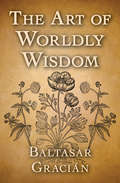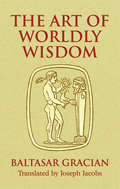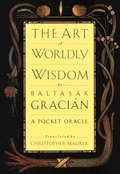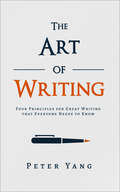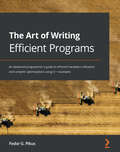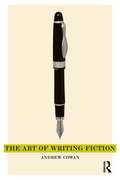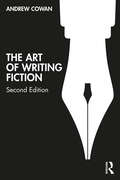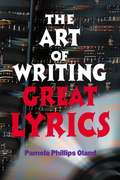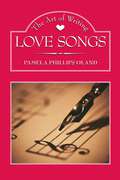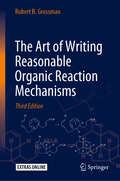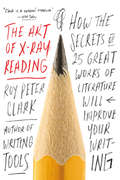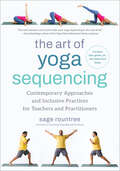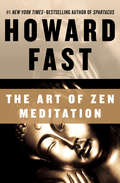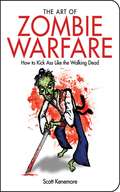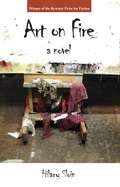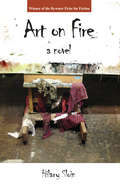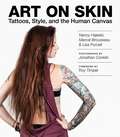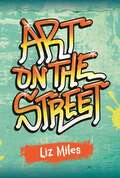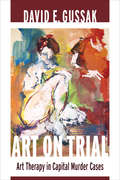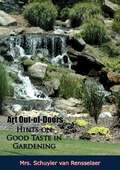- Table View
- List View
The Art of Worldly Wisdom
by Baltasar GraciánLife guidance from a famed Renaissance man. This influential work of philosophy by one of the great thinkers of the Renaissance era advises people of all walks of life how to approach political, professional, and personal situations in a dog-eat-dog world. Comprised of three hundred pithy aphorisms, it offers thought-provoking and accessible advice. Some subjects include &“Never Compete,&” &“The Art of Letting Things Alone,&” and &“Anticipate Injuries and Turn Them into Favours.&” This ebook has been professionally proofread to ensure accuracy and readability on all devices.
The Art of Worldly Wisdom
by Joseph Jacobs Baltasar Gracián"Think with the few and speak with the many," "Friends are a second existence," and "Be able to forget" are among this volume's 300 thought-provoking maxims on politics, professional life, and personal development. Published in 1637, it was an instant success throughout Europe. The Jesuit author's timeless advice, focusing on honesty and kindness, remains ever popular. A perfect browsing book of mental and spiritual refreshment, it can be opened at random and appreciated either for a few moments or for an extended period.
The Art of Worldly Wisdom: A Pocket Oracle
by Christopher Maurer Baltasar GracianThe remarkable best-seller -- a long-lost, 300-year-old book of wisdom on how to live successfully yet responsibly in a society governed by self-interest -- as acute as Machiavelli yet as humanistic and scrupulously moral as Marcus Aurelius.From the Hardcover edition.
The Art of Writing: Four Principles for Great Writing that Everyone Needs to Know
by Peter YangRediscover the lost art of excellent writing—a valuable skill through the ages, and even more so in the twenty-first century.Since the invention of writing, the written word has fueled humanity’s astonishing progress. Thus, the ability to write effectively and beautifully has long been revered and rewarded.And yet in the digital age, people have begun to believe that this talent is somehow obsolete: that writing is something unworthy of study beyond the basic mechanics of vocabulary and syntax and grammar, that mediocre prose is acceptable in a world crying out for clear and precise communication.Peter Yang believes otherwise.The Art of Writing is Yang’s highly practical treatise on the four key principles of dazzling, effective writing—economy, transparency, variety, and harmony. Far from your garden-variety style guide, this book offers principles that apply to everyone, whether you’re writing an inauguration speech, a novel, or a letter home to Mom.Great writing is a skill, and this book gives you the tools to make your words shimmer on the page (or the screen). Packed with real-world insights and advice, The Art of Writing is your ultimate guide to transforming your writing and unleashing your inner artist.
The Art Of Writing Advertising
by Denis HigginsConversations, in question and answer format, with William Bcrnbach (Doyle Dane Bernbach), Leo Burnett (Leo Burnett & Co.). George Gribbin (Young & Rubicam), David Ogilvy (Ogilvy & Mather), and Rosser Reeves (Ted Bates & Co.). Through candid interviews with some of America's pioneers in advertising, readers will learn techniques for creating ad campaigns that get results. This book was written long before people had home computers or used the internet; However the principles these men explain are still used today by companies as diverse as Google, General Foods, and American Airlines.
The Art of Writing Efficient Programs: An advanced programmer's guide to efficient hardware utilization and compiler optimizations using C++ examples
by Fedor G. PikusBecome a better programmer with performance improvement techniques such as concurrency, lock-free programming, atomic operations, parallelism, and memory managementKey FeaturesLearn proven techniques from a heavyweight and recognized expert in C++ and high-performance computingUnderstand the limitations of modern CPUs and their performance impactFind out how you can avoid writing inefficient code and get the best optimizations from the compilerLearn the tradeoffs and costs of writing high-performance programsBook DescriptionThe great free lunch of "performance taking care of itself" is over. Until recently, programs got faster by themselves as CPUs were upgraded, but that doesn't happen anymore. The clock frequency of new processors has almost peaked, and while new architectures provide small improvements to existing programs, this only helps slightly. To write efficient software, you now have to know how to program by making good use of the available computing resources, and this book will teach you how to do that. The Art of Efficient Programming covers all the major aspects of writing efficient programs, such as using CPU resources and memory efficiently, avoiding unnecessary computations, measuring performance, and how to put concurrency and multithreading to good use. You'll also learn about compiler optimizations and how to use the programming language (C++) more efficiently. Finally, you'll understand how design decisions impact performance. By the end of this book, you'll not only have enough knowledge of processors and compilers to write efficient programs, but you'll also be able to understand which techniques to use and what to measure while improving performance. At its core, this book is about learning how to learn.What you will learnDiscover how to use the hardware computing resources in your programs effectivelyUnderstand the relationship between memory order and memory barriersFamiliarize yourself with the performance implications of different data structures and organizationsAssess the performance impact of concurrent memory accessed and how to minimize itDiscover when to use and when not to use lock-free programming techniquesExplore different ways to improve the effectiveness of compiler optimizationsDesign APIs for concurrent data structures and high-performance data structures to avoid inefficienciesWho this book is forThis book is for experienced developers and programmers who work on performance-critical projects and want to learn new techniques to improve the performance of their code. Programmers in algorithmic trading, gaming, bioinformatics, computational genomics, or computational fluid dynamics communities will get the most out of the examples in this book, but the techniques are fairly universal. Although this book uses the C++ language, the concepts demonstrated in the book can be easily transferred or applied to other compiled languages such as C, Java, Rust, Go, and more.
The Art of Writing Fiction
by Andrew CowanThe Art of Writing Fiction guides the reader through the processes of creative writing from journal-keeping to editing, offering techniques for stimulating creativity and making language vivid. Readers will master key aspects of fiction such as structure, character, voice and setting. Andrew Cowan provides an insightful introduction that brings his own well-crafted prose style to bear on the processes and pleasures of writing fiction, offering practical and personal advice culled from his own experience and that of other published writers. He lays open to the reader his own notes, his writing, and the experiences from his own life that he has drawn on in his fiction allowing the reader to develop their own writing project alongside the author as they go through the book.
The Art of Writing Fiction
by Andrew CowanAn elegant and intimate insight into the personal and practical processes of writing, Andrew Cowan’s The Art of Writing Fiction draws on his experience as a prize-winning novelist and his work with emerging writers at the University of East Anglia. As illuminating for the recreational writer as for students of Creative Writing, the twelve chapters of this book correspond to the twelve weeks of a typical university syllabus, and provide guidance on mastering key aspects of fiction such as structure, character, voice, point of view, and setting, as well as describing techniques for stimulating creativity and getting the most out of feedback. This new edition offers extended consideration to structure, point of view, and the organisation of time in the novel, as well as the conduct of the Creative Writing workshop in the light of the decolonising the curriculum movement. It features additional writing exercises, as well as an afterword with invaluable advice on approaching agents and publishers. The range of writers surveyed is greatly expanded, finding inspiration and practical guidance in the work of Margaret Atwood, Ayanna Lloyd Banwo, Richard Beard, Tsitsi Dangarembga, Richard Ford, Ashley Hickson-Lovence, Anjali Joseph, James Joyce, James Kelman, Ian McEwan, Arundhati Roy, Sam Selvon, Vikram Seth, and Ali Smith, among many others. With over 80 writing exercises and examples taken from dozens of novels and short stories, the new edition of The Art of Writing Fiction is enriched by the author’s own experience as a novelist and lecturer, making it an essential guide for readers interested in the theory, teaching, and practice of Creative Writing.
The Art of Writing Fiction
by Andrew CowanAn elegant and intimate insight into the personal and practical processes of writing, Andrew Cowan’s The Art of Writing Fiction draws on his experience as a prize-winning novelist and his work with emerging writers at the University of East Anglia.As illuminating for the recreational writer as for students of Creative Writing, the twelve chapters of this book correspond to the twelve weeks of a typical university syllabus, and provide guidance on mastering key aspects of fiction such as structure, character, voice, point of view, and setting, as well as describing techniques for stimulating creativity and getting the most out of feedback.This new edition offers extended consideration to structure, point of view, and the organisation of time in the novel, as well as the conduct of the Creative Writing workshop in the light of the decolonising the curriculum movement. It features additional writing exercises, as well as an afterword with invaluable advice on approaching agents and publishers. The range of writers surveyed is greatly expanded, finding inspiration and practical guidance in the work of Margaret Atwood, Ayanna Lloyd Banwo, Richard Beard, Tsitsi Dangarembga, Richard Ford, Ashley Hickson-Lovence, Anjali Joseph, James Joyce, James Kelman, Ian McEwan, Arundhati Roy, Sam Selvon, Vikram Seth, and Ali Smith, among many others.With over 80 writing exercises and examples taken from dozens of novels and short stories, the new edition of The Art of Writing Fiction is enriched by the author’s own experience as a novelist and lecturer, making it an essential guide for readers interested in the theory, teaching, and practice of Creative Writing.
The Art of Writing Great Lyrics
by Pamela Phillips OlandPacked with literally hundreds of hints, tips, and inside information only a working writer would know, The Art of Writing Great Lyrics demonstrates proven, no-fail methods for everything from communicating through song, defining styles, and collaborating with a partner to studying the market, making a great demo, and getting started on a career. Full of creative exercises, writing do's and don'ts, and a handy A to Z checklist for reviewing new songs, The Art of Writing Great Lyrics provides a lifetime of proven success tips in one indispensable volume.
The Art of Writing Love Songs
by Pamela Phillips OlandFinally—the first songwriting guide to the most popular music genre in history! Written by a professional songwriter, The Art of Writing Love Songs provides inspiration to anyone seeking to write captivating songs about the most enduring musical subject of all. Readers will discover how to express their feelings in lyrics, master a wide scope of emotions and moods, choose an appropriate musical style, and craft beautiful songs that will woo any audience. This user-friendly guide presents technical information with precision, yet wrapped in a conversational, personal tone that&’s entertaining and easy to read. Packed with references to favorite hit songs, this must-have guide enables songwriters and musicians to understand and express love in a whole new way.
The Art of Writing Reasonable Organic Reaction Mechanisms
by Robert B. GrossmanIntended for students of intermediate organic chemistry, this text shows how to write a reasonable mechanism for an organic chemical transformation. The discussion is organized by types of mechanisms and the conditions under which the reaction is executed, rather than by the overall reaction as is the case in most textbooks. Each chapter discusses common mechanistic pathways and suggests practical tips for drawing them. Worked problems are included in the discussion of each mechanism, and "common error alerts" are scattered throughout the text to warn readers about pitfalls and misconceptions that bedevil students. Each chapter is capped by a large problem set.
The Art of X-Ray Reading: How the Secrets of 25 Great Works of Literature Will Improve Your Writing
by Roy Peter ClarkRoy Peter Clark, one of America's most influential writing teachers, offers writing lessons we can draw from 25 great texts.Where do writers learn their best moves? They use a technique that Roy Peter Clark calls X-ray reading, a form of reading that lets you penetrate beyond the surface of a text to see how meaning is actually being made. In THE ART OF X-RAY READING, Clark invites you to don your X-ray reading glasses and join him on a guided tour through some of the most exquisite and masterful literary works of all time, from The Great Gatsby to Lolita to The Bluest Eye, and many more. Along the way, he shows you how to mine these masterpieces for invaluable writing strategies that you can add to your arsenal and apply in your own writing. Once you've experienced X-ray reading, your writing will never be the same again.
The Art of Yoga Sequencing: Contemporary Approaches and Inclusive Practices for Teachers and Practitioners-- For basic, flow, gentle, yin, and restorative styles
by Sage RountreeAn inclusive guide for yoga teachers and practitioners to create balanced movement sequences and well-rounded classes for all students.Discover a unified theory for sequencing fresh, contemporary yoga and mindful-movement classes that reflect the diversity of modern practitioners.Yoga instruction innovator Sage Rountree&’s approach to teaching grows from a simple truth: bodies feel better when they move in many different ways and directions.But in a social-media fueled yoga scene that over-celebrates acrobatic, unrealistic poses, it&’s easy for even the most experienced instructor to lose touch with their students. The fix is clear: Real students need simple lessons taught clearly. Yoga teacher, trainer, and bestselling author Sage Rountree draws on years of expert experience to offer a fresh, contemporary approach to yoga sequencing and mindful movement that reflects the diversity and meets the needs of the modern yogi.The Art of Yoga Sequencing celebrates students of all kinds, styles, and levels. Grounded in exercise physiology while honoring yoga traditions, Rountree&’s new offering includes:Adaptable examples, templates, and preset lesson plans475 inclusive photos demonstrating over 35 full sequencesActionable tips for increasing student accessibilityCreative ideas for props, lighting, music, and moreWhether you&’re a current or aspiring teacher or advanced practitioner, you&’ll find here every tool you need to create inspired yoga classes and home practices. Even if you teach in a set format—like at a franchise or strongly branded studio—this yoga tool kit will help you lead students along any path with a clarity that honors all bodies.
The Art of Zen Meditation
by Howard FastBestselling author Howard Fast&’s straightforward introduction to Zen meditationHoward Fast began to formally practice Zen meditation after turning away from communism in 1956. The Art of Zen Meditation, originally published by the antiwar political collective Peace Press in 1977, is the fruit of Fast&’s study: a brief and instructive history of Zen Buddhism and its tenets, written with a simplicity that is emblematic of the philosophy itself. Fast&’s study of Zen also inspired his popular Masao Masuto mystery series about a Zen Buddhist detective in Beverly Hills, which he published under the pseudonym E. V. Cunningham. The Art of Zen Meditation is illustrated with twenty-three beautiful photographs. This ebook features an illustrated biography of Howard Fast including rare photos from the author&’s estate.
The Art of Zombie Warfare: How to Kick Ass Like the Walking Dead (Zen of Zombie Series)
by Adam Wallenta Scott KenemoreSun Tzu meets George Romero in Scott Kenemore's third zombie book. 40 color illustrations
The Art of Zootropolis
by Jessica Julius John Lasseter Byron Howard Rich MooreDisney's newest animated feature, Zootropolis, is a comedy-adventure starring Officer Judy Hopps, a rookie bunny cop who has to team up with fast-talking scam-artist fox Nick Wilde to crack her first case in the all-animal city of Zootropolis. This lushly illustrated book offers a behind-the-scenes view of the elaborate artistry involved in creating the film.
Art on Fire
by Hilary SloinArt on Fire is the apparent biography of subversive painter Francesca deSilva, the founding foremother of "pseudorealism," who lived hard and died young. But in the tradition of Vladimir Nabokov's acclaimed novel Pale Fire, it's a fiction from start to finish. It opens with Francesca's early life. We learn about her childhood love, the chess genius Lisa Sinsong, as well as her rivalry with her brilliant sister Isabella, who publishes an acclaimed volume of poetry at the age of twelve. She compensates for the failings of her less than attentive parents by turning to her grandmother who is loyal and adoring until she learns Francesca is a lesbian, when she rejects her. Francesca flees to a ramshackle cabin in Wellfleet, Massachusetts, working weekends at the flea market. She breaks into the gloomy basement of a house, where she begins her life as a painter. Much to her confusion and even dismay, fame comes quickly. Interspersed with Francesca's narrative are thirteen critical "essays" on the paintings of Francesca deSilva by critics, academics, and psychologists-essays that are razor-sharp satires on art, lesbian life, and the academic world, puncturing pretentiousness with every paragraph. Art on Fire is a darkly comic, pitch-perfect, and fearless satire on the very art of biography itself. Art on Fire is the latest winner of the Bywater Prize for Fiction and was a finalist for the Heekin Foundation Award, the Dana Awards, and the Story Oaks Prize. It was mistakenly awarded the nonfiction prize in the Amherst Book and Plow Competition.
Art on Fire
by Hilary SloinArt on Fire is the apparent biography of subversive painter Francesca deSilva, the founding foremother of "pseudorealism," who lived hard and died young. But in the tradition of Vladimir Nabokov's acclaimed novel Pale Fire, it's a fiction from start to finish. It opens with Francesca's early life. We learn about her childhood love, the chess genius Lisa Sinsong, as well as her rivalry with her brilliant sister Isabella, who publishes an acclaimed volume of poetry at the age of twelve. She compensates for the failings of her less than attentive parents by turning to her grandmother who is loyal and adoring until she learns Francesca is a lesbian, when she rejects her. Francesca flees to a ramshackle cabin in Wellfleet, Massachusetts, working weekends at the flea market. She breaks into the gloomy basement of a house, where she begins her life as a painter. Much to her confusion and even dismay, fame comes quickly. Interspersed with Francesca's narrative are thirteen critical "essays" on the paintings of Francesca deSilva by critics, academics, and psychologists--essays that are razor-sharp satires on art, lesbian life, and the academic world, puncturing pretentiousness with every paragraph. Art on Fire is a darkly comic, pitch-perfect, and fearless satire on the very art of biography itself. Art on Fire is the latest winner of the Bywater Prize for Fiction and was a finalist for the Heekin Foundation Award, the Dana Awards, and the Story Oaks Prize. It was mistakenly awarded the nonfiction prize in the Amherst Book and Plow Competition.
Art on Sight: The Best Art Walks In and Near New York City
by Lucy D. Rosenfeld Marina HarrisonThe complete art-lovers guide to all the known and unknown art in New York City. Art on Sight: The Best Outings In and Near New York City invites readers to see public art in a wide variety of venues and applications. Covering the five boroughs of New York City and nearby sites close to the city, it features information on sculpture gardens, lobby art, underground art, cemetery art, stained glass windows, ethnic art, art auction houses and design centers. Each site description includes complete directions, web sites and information concerning hours, fees and other pertinent details.
Art on Skin: Tattoos, Style, and the Human Canvas
by Lisa Purcell Troy Timpel Marcel Brousseau Nancy Hajeski Jonathan ConklinA celebration of all things tattoo, this visually appealing wealth of tattoo knowledge will have you running for the nearest tattoo artist. The twenty-first century has seen a boom in tattooing, with millions of American's-23 percent of them-boasting ink on their body. This popular pastime is not something to be taken lightly, as there are dozens of aspects to consider when planning your ink. Art on Skin helps with that planning by detailing the different types of art, ink, and artists that pervade the industry.Using striking visuals, Art on Skin showcases the beauty of the art of tattooing and aids in the choosing of a style, with detailed descriptions of the many different styles of tattoos, including fine art, cartoon characters, wildlife, and many more. The full-color photographs within these pages will leave you with dreams of your own pieces, and stories from others who have lived the tattoo experience will keep you from stumbling upon unwelcome surprises. This is the perfect book for tattoo lovers and prospective tattoo junkies of all kinds.
Art on Trial: Art Therapy in Capital Murder Cases
by David GussakA man kidnaps his two children, murders one, and attempts to kill the other. The prosecution seeks the death penalty, while the defense employs an unusual strategy to avoid the sentence. The defendant's attorneys turn to more than 100 examples of his artwork, created over many years, to determine whether he was mentally ill at the time he committed the crimes. Detailing an outstanding example of the use of forensic art therapy in a capital murder case, David Gussak, an art therapist contracted by the defense to analyze the images that were to be presented as evidence, recounts his findings and his testimony in court, as well as the future implications of his work for criminal proceedings. <P><P>Gussak describes the role of the art therapist as an expert witness in a murder case, the way to use art as evidence, and the conclusions and assessments that professionals can draw from a defendant's artworks. He examines the effectiveness of expert testimony as communicated by the prosecution, defense, and court, and weighs the moral, ethical, and legal consequences of relying on such evidence. For professionals and general readers, this gripping volume presents a convincing account of the ability of art to reflect a damaged and dangerous psyche. A leading text on an emerging field, Art on Trial demonstrates the practical applications of an innovative approach to clinical assessment and treatment.
Art Out-of-Doors: Hints on Good Taste in Gardening
by Mrs Schuyler Van RensselaerAn explanation of the essential principles of landscape gardening so that readers from all walks of life may admire the beauty of a well-designed formal garden.Landscape gardening as an art, in its practical application to the beautifying of country places, is the subject of a book by Mrs. Van Rensselaer, who writes with thorough knowledge and with fresh enthusiasm. She gives information and hints in abundance relating to the treatment of grounds, roads and paths, piazzas, pattern beds, trees and shrubs, etc., all animated by a fine artistic taste and a very genuine love of nature. It is very practical and helpful, and is written in the same agreeable manner that characterizes all of Mrs. Van Rensselaer’s writings.CONTENTS: THE ART OF GARDENING—AIMS AND MEANS—HOME GROUNDS—CLOSE TO THE HOUSE—ROADS AND PATHS—PIAZZAS—WINTER BEAUTY—A WORD FOR ARCHITECTURE—PATTERN BEDS—FORMAL GARDENING—THE BEAUTY OF TREES—BOTANY AND BEAUTY—THE ARTIST—THE LOVE OF NATURE, ETC., ETC.
